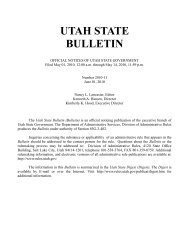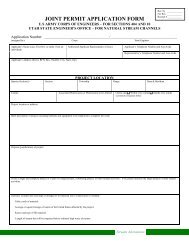Vol. 2007, No. 15 (08/01/2007) PDF - Administrative Rules - Utah.gov
Vol. 2007, No. 15 (08/01/2007) PDF - Administrative Rules - Utah.gov
Vol. 2007, No. 15 (08/01/2007) PDF - Administrative Rules - Utah.gov
You also want an ePaper? Increase the reach of your titles
YUMPU automatically turns print PDFs into web optimized ePapers that Google loves.
NOTICES OF PROPOSED RULES DAR File <strong>No</strong>. 3<strong>01</strong>80<br />
(i) the date, time, and circumstances surrounding the transfer<br />
or placement;<br />
(ii) the client and staff involved;<br />
(iii) communications with the client's guardian;<br />
(iv) methods of transfer used, including transportation and<br />
safety plans;<br />
(v) verification that the client's guardian, if any, has accepted<br />
physical custody of the client or approved the transfer of physical<br />
custody of the client to an individual designated by the guardian in<br />
writing;<br />
(vi) date, signature and title of staff preparing report; and<br />
(vii) date and signature of the program director approving the<br />
report.<br />
(17) The program's grievance policy shall describe how a<br />
grievance may be made, who shall investigate and complete a<br />
written report regarding each grievance, and an appeal process.<br />
(a) The program, its <strong>gov</strong>erning body and its staff shall not<br />
retaliate against any person who makes a complaint or grievance.<br />
(b) Grievances shall be retained in grieving client's or grieving<br />
staff's file, and a copy shall be retained in a separate file<br />
documenting all grievances together with the investigation and<br />
resolution.<br />
(18) Changes to the program's services, policies and<br />
procedures shall be disclosed to clients or clients' guardians prior to<br />
any change.<br />
R5<strong>01</strong>-2-8. Off-site Activities.<br />
(1) A program that offers off-site activities for clients shall<br />
describe in the program's policies and procedures manual which<br />
types of off-site activities, including but not limited to specific types<br />
of mountain sports, water sports, shopping trips, and field trips, are<br />
permitted and which are prohibited, and shall:<br />
(a) address risk factors associated with taking clients off-site<br />
for each type of activity permitted by the program;<br />
(b) address risk factors associated with the client population<br />
that may participate in off-site activities;<br />
(c) identify high-risk clients and require staff to remain within<br />
sight or hearing of high-risk clients;<br />
(d) describe the minimum direct care staff-to-client ratio<br />
required for each type of activity permitted by the program, which<br />
shall never be less than the minimum direct care staff-to-client ratio<br />
required by categorical rule;<br />
(e) describe what physical and behavioral prerequisites a client<br />
must meet in order to participate in each type of activity permitted<br />
by the program; and<br />
(f) include a safety plan, including but not limited to<br />
communication, emergency and evacuation procedures, for each<br />
type of activity permitted by the program.<br />
(2) A program shall obtain the written consent of the adult<br />
client or the client's guardian for each type of off-site activity prior<br />
to permitting the client to participate in the activity, but is not<br />
required to obtain an additional consent each time the client<br />
participates in the same activity.<br />
(3) Staff involved in the off-site activity shall be familiar with<br />
the location and activity.<br />
(a) A program may contract with an experienced professional<br />
guide to conduct an activity as long as the client's legal guardian<br />
grants permission and the program maintains responsibility for the<br />
health and safety of the participants.<br />
(4) A program shall provide safety equipment, supplies, staff<br />
training, and client training for each person participating in the<br />
activity.<br />
R5<strong>01</strong>-2-9. Behavior Management.<br />
(1) The program policies and procedures shall describe all<br />
methods of behavior management permitted by the program. These<br />
shall include:<br />
(a) definition of appropriate and inappropriate behaviors;<br />
(b) acceptable staff responses to inappropriate behaviors;<br />
(i) staff shall only use behavior management techniques<br />
appropriate for the age, behavior, needs, and developmental level of<br />
a client;<br />
(ii) staff shall only use behavior management techniques that<br />
are positive, consistent, and that promote self-control, self-esteem,<br />
and independence;<br />
(iii) staff shall not use physical work assignments or activities<br />
that inflict pain as behavior management techniques;<br />
(A) a physical work assignment or activity that results in minor<br />
sore muscles does not violate subsection(1)(b)(iii);<br />
(iv) staff shall not abuse, threaten, humiliate, ridicule, degrade,<br />
or frighten a client;<br />
(v) staff shall not deny a client medical care, food, hydration,<br />
clothing, bedding, sleep, toilet and bathing facilities, or any clients'<br />
rights;<br />
(vi) staff shall not use nor permit the use of a mechanical<br />
restraint, chemical restraint, physical force, or the infliction of pain<br />
to discipline, coerce, punish, or retaliate against a client;<br />
(vii) staff shall not place nor permit another to place anything<br />
on a client's face, over a client's head, or in a client's mouth to<br />
discipline, coerce, punish, or retaliate against a client;<br />
(c) staff shall use the least restrictive method of behavior<br />
management available to control a situation; and<br />
(d) staff shall not use behavior management techniques that are<br />
not specifically authorized by the program's written policy and<br />
procedures.<br />
(2) Staff shall receive training relative to behavior management<br />
at least annually.<br />
(3)(a) Staff shall not use nor permit the use of any physical<br />
restraint with the exception of passive physical restraint.<br />
Passive physical restraint shall be used only as a temporary<br />
means of physical containment to protect the client, other persons, or<br />
property from harm.<br />
(c) Passive physical restraint shall not be used to discipline,<br />
coerce, punish, or retaliate against a client.<br />
(d) Passive physical restraint shall be documented in an<br />
incident report.<br />
(e) Passive physical restraint shall be applied only by staff who<br />
are trained in accordance with the non-violent intervention strategies<br />
of a State, regional or national recognized program.<br />
(f) Passive physical restraint shall be applied only as long as<br />
necessary to calm the client, and shall not exceed 30 minutes unless<br />
a mental health therapist, a medical practitioner, or a behavior<br />
consultant in a program that is under exclusive contract with DSPD<br />
and provides services only to DSPD clients, remains present on site,<br />
evaluates the client, and determines that the restraint remains<br />
necessary.<br />
36 UTAH STATE BULLETIN, August 1, <strong>2007</strong>, <strong>Vol</strong>. <strong>2007</strong>, <strong>No</strong>. <strong>15</strong>


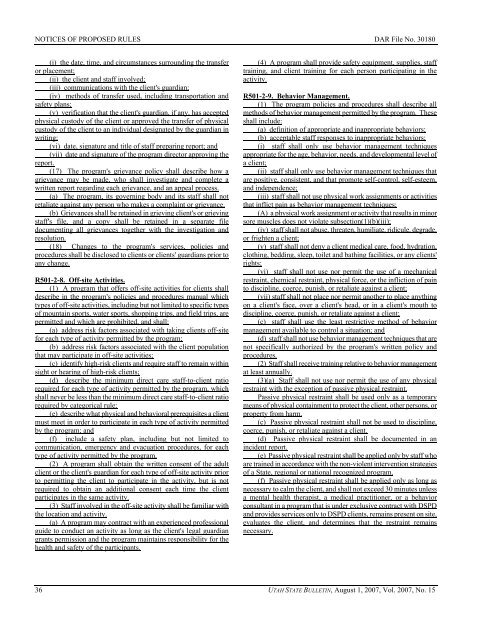
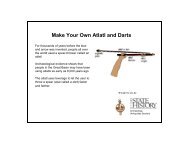

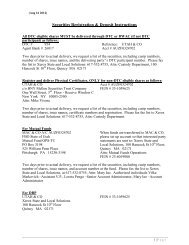
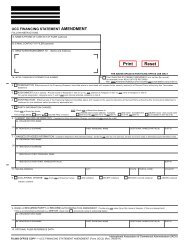
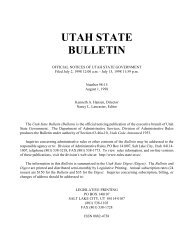
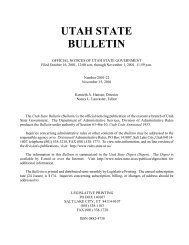

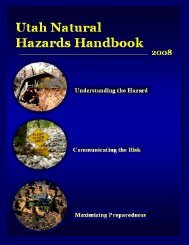

![Lynx avoidance [PDF] - Wisconsin Department of Natural Resources](https://img.yumpu.com/41279089/1/159x260/lynx-avoidance-pdf-wisconsin-department-of-natural-resources.jpg?quality=85)
